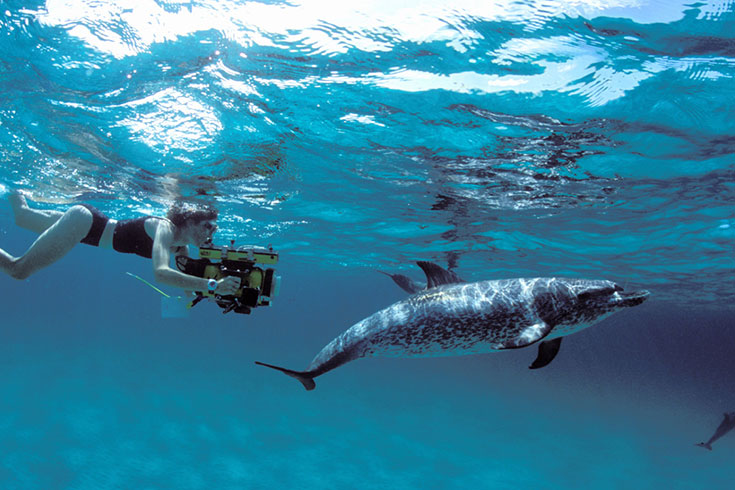For almost a quarter of a century, Dr. Kathleen Dudzinski has been getting beneath the surface – literally – during her studies of some of the ocean’s most mysterious mammals – dolphins. Director of the Dolphin Communication Project, Dudzinski’s area of focus is – you guessed it – dolphin communication, specifically, looking at the ways they use sounds – also known as “bioacoustics” – and body language to give each other the four-one-one.
Since 1991, the scientist has been getting up close and personal with Atlantic spotted and bottlenose dolphins, eavesdropping on their ‘conversations’ in her observations and data collection. Conducting research on three groups of dolphins, her work takes her across the globe, from The Bahamas and Honduras to Japan. She began collaborating with the Dolphin Encounters team in 2006, and has been making regular visits to Blue Lagoon Island ever since.
What, first and foremost, do you do?
I study dolphin communication, which is looking at their acoustics and their behavior and trying to get an idea of what kind of signals they use to share information with one another. For me, I’m very interested in how dolphins share information, but also the ways that social mammals in the water share information that might be different or similar to other social animals.
So, how is it different or similar?
Well, the reason why dolphin communication [with each other] seems so different is because dolphins are fully aquatic and their bodies are so different, but it really isn’t…One of the projects I looked at recently is pectoral fin contact, and how touch between dolphins, specifically with the pectoral fin or another fin or flipper, or their bodies, can signify something. Flipper to flipper contact is kind of like handshakes with human beings. Flipper to body might be an appeasement, say, if someone is a little nervous or lacks confidence, or, maybe, if two dolphins are just hanging out. It’s similar to grooming behavior in chimpanzees, and similar to how we hang out, as humans.
Why do you think it’s so important to understand dolphin communication?
I’m interested in seeing how dolphins fit on the continuum with other social animals; I think it’s important to understand what’s similar about the signals we share and what’s different. The more we understand about other species, the more we can interact and understand our place in the animal kingdom. It helps us to figure out how best to foster education and conservation programs, because learning and understanding their signals and the information they share with one another helps to shape our conservation programs.
How do you get the data you need?
I study wild and captive dolphins through the Dolphin Communication Project, and our protocol and our method of collecting data is exactly the same. I have my underwater camera system, which has stereo hydrophones, which are underwater microphones, scaled to the distance between our ears to be able to hear where sounds are coming from underwater. Those hydrophones are cabled through the underwater housing and plugged into a stereo video camera. That means we can record dolphin behavior and sound simultaneously, on the same tape, underwater…What I’ve learned, over the years, is that documenting and recording with video is the only way to do it, because there are so many subtle interactions. They’re much faster and elegant underwater than we are, so it’s a lot easier to sit with a video and remote to see exactly what’s going on between dolphins.
What’s the general reaction to the work you do?
The first reaction I get from people is normally something like, ‘Oh! Can we communicate with dolphins?’ And there are two ways to respond to that. The first is, ‘Well, yes we can, but not in the way that I think you think we can communicate.’ A lot of people confuse language and communication…Dolphins have a vocabulary, but not a language. They use sounds, postures and gestures and various visual information to share information, which is very similar to human beings. Often, I’ll say to adults, ‘You know your significant other can just give you a look – they don’t even have to say anything – and you know exactly what it means.’
What’s one last thing you think people should know about your work?
I’ve been studying wild dolphins since the early 90s, and it’s been almost a decade for various captive dolphins. I’ve studied a couple groups of wild dolphins, dolphins [at Dolphin Encounters] and dolphins in Germany, in a man-made pool. And, by collecting data the exact same way, in all the sites, and analyzing it in exactly the same way, in all the sites, we can do direct comparisons. So, we looked at them to see if there are significant differences or similarities in dolphin interaction, and I have not found any significant differences in dolphin behavior when I’ve used those methodologies. So, when you have a group of animals that are healthy and happy and they have a good social environment, I don’t see any differences between wild dolphins and captive dolphins. I think that’s pretty cool given worldwide media.
Dr. Kathleen Dudzinski


